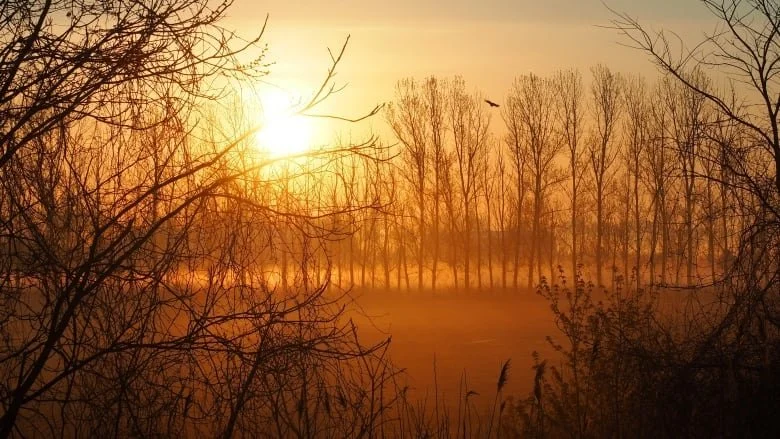The former executive of a now-bankrupt mining company has been fined nearly $30,000 for environmental violations dating back to 2015 — an amount that has led to competing appeals from both sides. The charges follow a July 7 ruling from B.C. provincial court judge David Patterson, who said Benjamin Mossman was "actively or passively involved" in releasing excess zinc and other substances into woods and wetlands on Banks Island in Gitxaała First Nation territory. He was fined $29,994, according to the B.C. Conservation Officer Service, which led the joint investigation into the allegations in the initial stages.
How climate change is impacting Canada's largest wetland
One of the few amphibians that can survive the harsh winter conditions of boreal and subarctic areas is the wood frog, a prime example of organisms poised to feel the effects of climate change in the region. But these frogs need up to two months to develop from tadpoles and grow before the onset of summer. As the changing climate in the region shortens the window of time between snowmelt and the beginning of summer, frogs may be smaller when they emerge.
Alberta regulator reconsiders Fort Hills oilsands approval after critical report
The plan proposes a complicated set of wells and pumps to control and monitor water levels and chemistry. But its centrepiece is a wall, nearly 14 kilometres long and between 20 and 70 metres deep, which is intended to protect the unmined wetland while the rest is drained and excavated. “It is untested,” said Lorna Harris, an ecologist specializing in peat with the Wildlife Conservation Society, who has worked at universities in Canada and England. “We do not have any certainty that it will work.”
Government of Canada Invests in Upgrades to Heart Lake Conservation Park
Toronto and Region Conservation Authority’s (TRCA) Heart Lake Conservation Park has received funding from the Government of Canada that will help create more community access to this valuable greenspace. On March 26, MP Ruby Sahota and TRCA CEO John MacKenzie were present at Heart Lake Conservation Park to make the announcement and recognize the vital work that will be accomplished with this investment support. As part of the Canada Community Revitalization Fund (CCRF), over $660,000 in federal government funding will go towards essential infrastructure improvements to strengthen accessibility, the use of the greenspace, and the overall visitor experience at this location.
Conservation group opposes oilsands mining project on northern Alberta wetland
An Alberta conservation group is raising concerns about the potential for environmental damage from an approved oilsands mining operation on an important wetland in northern Alberta. The Alberta Energy Regulator approved Suncor's plan for work in the McClelland Lake Wetland Complex last year. The project is part of the company's current Fort Hills oilsands operation.
Rewilding a school wetland is a lesson in climate resilience
The 60-plus children recently gathered with members of the We Wai Kai Nation, Quadra Island school and community leaders and the B.C. Wildlife Federation to celebrate their new wetland restoration project by planting a selection of native trees and shrubs. The wetland will provide a habitat for endemic plants and animals and serve as an outdoor classroom for students, said Sheldon Etheridge, the School District 72 teacher who spearheaded the project. Nothing underscores the importance of protecting or restoring wetlands at a community level like drought conditions across the province provoked by a global climate crisis. “It’s exciting. The project’s all coming together,” Etheridge said. “Except for the water.”
Wetland at Okanagan Falls sewer plant now fully up and running
The wetland project next to the Okanagan Falls wastewater treatment plant to polish treated effluent is now fully operational. The new wetland is operated by the Regional District of Okanagan-Similkameen and comprises 1.9 hectares of floodplain land adjacent to the Okanagan River. According to the RDOS, while wastewater treatment plant discharges clean effluent, during the summer months, the wetland allows for an additional one-third reduction of nitrogen and phosphorus loading to the Okanagan River.
Water stewardship group, Gibson Energy team up to combat invasive purple loosestrife plant
Just as leafy spurge looks harmless but is really an invasive species, purple loosestrife is another attractive-looking plant that can do more damage to the local environment. Purple loosestrife is a wetland invasive species that has taken over the river systems in Eastern Canada. While it looks like a beautiful flower, it is extremely aggressive and can wipe out cattails and other native flora. If its seeds spread, they can choke out wetlands. Purple loosestrife is native to Europe and Asia and was brought to North America in the early 19th century. It was likely introduced when its seeds were included in soil used as ballast in European sailing ships and discarded in North America.
Bad air, dirty water: Health fears follow carbon capture plans
But even if the technology was deployed successfully, several critics say the projects would pose threats to the public health of communities long plagued by air and water pollution… That's concerning for Nayamin Martinez, who lives in the valley and is the director of the Central California Environmental Justice Network. “That worries us a lot,” she said. “What does that mean in terms of risk for contamination of drinking water?”
Nova Scotia man constructs wetland on his property in tribute to his first love
When he first started, Perkins admits he got into trouble with provincial and municipal officials who he says were worried about the volume of water on his land. Jonathan Platts with Ducks Unlimited Canada works with landowners who want to build wetlands from scratch, as Perkins has done. "Constructed wetlands, starting them from scratch, and doing them right, I think you can still have very productive wetlands and ones that can certainly compliment your property and help wildlife," said Platts, who lives on P.E.I. and is the new head of wetland restoration for Ducks Unlimited in Atlantic Canada.
World Wetlands Day: Nature needs us to do more
If you used water today to brush your teeth, cook or quench your thirst, you should probably thank a wetland. World Wetlands Day, celebrated annually on February 2, is an opportunity to learn about the value and importance of wetlands. This year, it also serves as an opportunity to double down on our efforts to protect these vital natural spaces that are disappearing before our eyes. In a rapidly changing world, the more wetlands we lose, the more valuable the ones that remain.
Restoration work at Hillman Marsh to protect region from erosion, maintain wildlife
Two years after erosion at Hillman Marsh Conservation Area was considered "gravely concerning," the coastal wetland in Ontario is now undergoing restoration work to better protect it. In 2019, the Essex Region Conservation Authority (ERCA) told CBC News that erosion along the coastline — specifically along Wheatley Provincial Park, Hillman Marsh and Point Pelee National Park — was "active and significant."
Province installs 'control structure' to protect Fredericton wetland that was accidentally drained
The New Brunswick government says it's taking steps to prevent a Fredericton wetland from getting accidentally drained again. Transportation and Infrastructure Minister Jill Green said department staff are currently working to install a "water control structure" on a road culvert that's adjacent to the northside Ferris Street Wetland Nature Preserve, which was accidentally drained of about half a metre of water earlier this year.
Laval investigates after men wearing camouflage caught draining wetland
Officials in Laval, Que., working with police, have launched an investigation after green space advocates captured video of what appears to be camouflage-clad men covertly draining a patch of wetland over the weekend. It's still not known why the men allegedly dragged large pipes, a pump and hoses into a wooded sector near Saint-Elzéar Boulevard West, but Laval's deputy mayor, Stéphane Boyer, says it certainly won't lead to any construction permits being issued — if that was their plan.
A Mi’kmaq community’s fears of toxic water recede as Northern Pulp mill winds down
For decades, Pictou Landing First Nation has lived uneasily near an industrial plant emitting brown, foul-smelling waste and the effluent treatment facility they say causes respiratory and skin illnesses. Now, the mill is being mothballed. Ms. Francis, a member of Pictou Landing First Nation, fought for years to stop toxic wastewater from the Northern Pulp plant from being pumped into a tidal estuary next to her community. After decades of court battles, environmental studies and protests, people on the Nova Scotia reserve are hopeful they may one day be able trust their water and land again.
















